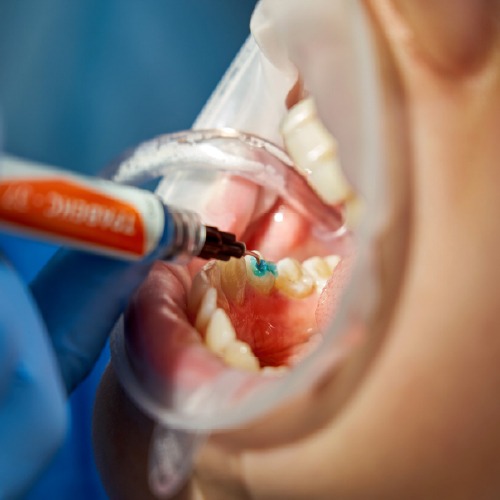If you’re experiencing tooth loss, your dentist has the option to use dental bridges to fill in the gaps. Essentially, a dental bridge involves anchoring a synthetic tooth (pontic) in position by connecting it to the adjacent teeth on either side of the space.
While pontics can be crafted from diverse materials like gold, the common choice is porcelain. This is primarily because porcelain allows for a seamless aesthetic integration with your natural teeth.
Varieties of Dental Bridges
There are four primary categories of dental bridge:
- Traditional
- Cantilever
- Maryland
- Implant-supported
Traditional dental bridges
A conventional dental bridges comprise a synthetic tooth or teeth anchored by dental crowns affixed to each of the abutment teeth through cementation. This type of bridge, known as a traditional dental bridges, is widely favored and applicable when natural teeth are present on both sides of the gap resulting from a missing tooth.
Cantilever dental bridge
Similar to a traditional dental bridge, a cantilever dental bridge features a pontic held in position by a dental crown affixed to just one abutment tooth, secured through cementation. With a cantilever dental bridge, the requirement is for only one natural tooth adjacent to the gap left by the missing tooth.
Maryland dental bridge
Resembling a conventional bridge, Maryland dental bridges utilize two natural abutment teeth—one on either side of the gap. Nevertheless, unlike a traditional bridge that relies on dental crowns for the abutment teeth, a Maryland bridge employs a framework made of either metal or porcelain, bonded onto the rear surfaces of the abutment teeth.
Just like a traditional bridge, the application of a Maryland bridge is contingent upon the presence of a natural tooth on each side of the gap resulting from the absence of one or more teeth.
Dental bridges supported by implants.
Top of Form
True to its name, implant-supported bridges rely on dental implants rather than crowns or frameworks. Typically, a surgical procedure involves placing one implant for each missing tooth, and these implants serve as anchors for securing the bridge in place. In cases where having one implant per missing tooth is not feasible, the bridge might feature a pontic suspended between two implant-supported crowns.
Recognized for its robustness and stability, the implant-supported bridge typically involves two surgical phases:
- The first surgery involves embedding the implants into the jawbone.
- The second surgery is dedicated to placing the bridge.
Completion of the entire procedure may span several months.

Is it costly process?
Several variables can impact the expense, such as:
- The number of teeth needed to fill the gap.
- The materials utilized, such as composite resin, zirconia, or metal alloy coated in resin.
- The complexity or difficulty of the placement procedure.
- Additional treatments for concurrent dental problems, like gum disease.
- Geographic location.
Top of Form
Contrasting dental bridges with dental implants.
Numerous dental insurance plans provide coverage for bridges, and an increasing number now include coverage for implants. The lifespan of a dental bridge typically ranges from 5 to 15 years, contingent upon adequate care, whereas implants are deemed a lasting solution. Various factors, such as dental hygiene, can impact the longevity of all bridge types, including implants.
The need for them
The absence of a tooth or multiple teeth can have various impacts on you. A dental bridge can effectively address these changes by:
- Restoring your smile.
- Restoring the ability to chew properly.
- Enhancing speech clarity and pronunciation.
- Preserving the inherent contours of your face.
- Re-establishing a balanced bite to evenly distribute chewing forces.
- Preventing remaining teeth from shifting out of their correct positions.
What is the Lifespan of Dental Bridges?
The durability of dental bridges can extend from five to 15 years and beyond. When coupled with proper oral hygiene and routine checkups, it is not uncommon for a fixed bridge to surpass a lifespan of 10 years.
Is Eating Challenging with a Dental Bridge?
Substituting missing teeth with a dental bridge can, in fact, facilitate easier eating. During the adjustment period to the bridge, consider consuming soft foods that are cut into smaller pieces.
Will the Dental Bridge Affect My Speech?
Speaking clearly can pose a challenge when teeth are absent. Wearing a dental bridge that positions the anterior teeth correctly can aid in maintaining proper speech
What Is the Proper Care for a Dental Bridge?
Maintaining the health and strength of the remaining teeth is crucial, as the success of the bridge, contingent on the chosen type, relies on a sturdy foundation provided by surrounding teeth. Consistent oral care practices, such as brushing twice a day, daily flossing, and the use of antiseptic mouthwash, aid in preventing tooth decay and gum disease that may lead to tooth loss. Your dentist or dental hygienist can demonstrate proper brushing and flossing techniques. Adhering to a regular cleaning schedule enables early detection of issues, improving the chances of successful treatment. Additionally, adopting a well-balanced diet ensures proper nutrition for overall oral health.
What Can You Anticipate?
The specific procedure varies based on the type of bridge.
For a traditional bridge, the process initiates by preparing the teeth on both sides of the gap. These teeth are ground down to remove any decay, and an impression of the mouth is taken for accurate bridge fitting. A temporary bridge is placed on the prepared teeth to safeguard them, and it’s essential to return to the dentist within a few weeks.
Upon completion of the real bridge, typically within two weeks, the temporary structures are removed, and the permanent bridge is affixed using a strong adhesive. In cases of intricate, long-span, or multiple bridges, the process may take several months, while implant bridges might require an extended period.
If the dentist has in-office equipment for crown and bridge fabrication, the procedure can be completed in a single day.
For cantilever and Maryland bridges, the process is similar, with fewer teeth requiring crowns. Implant-supported bridges usually commence with implant surgery, followed by an impression for creating a seamlessly fitting bridge over the implants. The overall timeline for these procedures may span multiple appointments.




